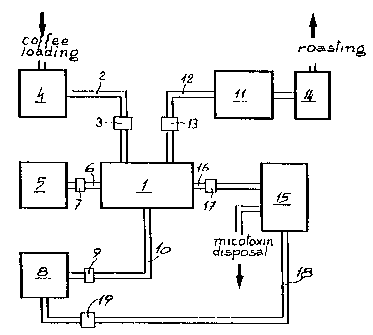Some of the information on this Web page has been provided by external sources. The Government of Canada is not responsible for the accuracy, reliability or currency of the information supplied by external sources. Users wishing to rely upon this information should consult directly with the source of the information. Content provided by external sources is not subject to official languages, privacy and accessibility requirements.
Any discrepancies in the text and image of the Claims and Abstract are due to differing posting times. Text of the Claims and Abstract are posted:
| (12) Patent: | (11) CA 2254752 |
|---|---|
| (54) English Title: | A PROCESS TO REMOVE MICOTOXINS FROM A LOAD OF GREEN COFFEE |
| (54) French Title: | PROCEDE POUR ENLEVER LES MICOTOXINES D'UNE CHARGE DE CAFE VERT |
| Status: | Term Expired - Post Grant Beyond Limit |
| (51) International Patent Classification (IPC): |
|
|---|---|
| (72) Inventors : |
|
| (73) Owners : |
|
| (71) Applicants : |
|
| (74) Agent: | SMART & BIGGAR LP |
| (74) Associate agent: | |
| (45) Issued: | 2004-08-24 |
| (86) PCT Filing Date: | 1997-04-22 |
| (87) Open to Public Inspection: | 1997-11-20 |
| Examination requested: | 2002-02-15 |
| Availability of licence: | N/A |
| Dedicated to the Public: | N/A |
| (25) Language of filing: | English |
| Patent Cooperation Treaty (PCT): | Yes |
|---|---|
| (86) PCT Filing Number: | PCT/EP1997/002014 |
| (87) International Publication Number: | WO 1997042831 |
| (85) National Entry: | 1998-11-12 |
| (30) Application Priority Data: | ||||||
|---|---|---|---|---|---|---|
|
Green coffee is kept in a container wherein steam is introduced until the
coffee beans become porous and permeable. A solvent suited to removing
micotoxins and waxes from the surface of the coffee is introduced and
extracted
again as soon as it has removed the desired amount of micotoxins from the
coffee.
Le café vert est conservé à l'état mélangé dans un récipient (1) dans lequel de la vapeur est introduite jusqu'à ce que les grains de café deviennent poreux et perméables, ce qui permet d'obtenir un solvant apte à enlever les cires de la surface desdits grains de café. Les micotoxines sont ensuite introduites et encore extraites jusqu'à ce que la quantité de micotoxines voulue ait été enlevée du café.
Note: Claims are shown in the official language in which they were submitted.
Note: Descriptions are shown in the official language in which they were submitted.

2024-08-01:As part of the Next Generation Patents (NGP) transition, the Canadian Patents Database (CPD) now contains a more detailed Event History, which replicates the Event Log of our new back-office solution.
Please note that "Inactive:" events refers to events no longer in use in our new back-office solution.
For a clearer understanding of the status of the application/patent presented on this page, the site Disclaimer , as well as the definitions for Patent , Event History , Maintenance Fee and Payment History should be consulted.
| Description | Date |
|---|---|
| Inactive: Expired (new Act pat) | 2017-04-22 |
| Inactive: IPC from MCD | 2006-03-12 |
| Grant by Issuance | 2004-08-24 |
| Inactive: Cover page published | 2004-08-23 |
| Pre-grant | 2004-06-15 |
| Inactive: Final fee received | 2004-06-15 |
| Inactive: Entity size changed | 2004-03-18 |
| Notice of Allowance is Issued | 2004-02-20 |
| Letter Sent | 2004-02-20 |
| Notice of Allowance is Issued | 2004-02-20 |
| Inactive: Approved for allowance (AFA) | 2003-12-24 |
| Amendment Received - Voluntary Amendment | 2003-11-10 |
| Letter Sent | 2002-03-25 |
| Amendment Received - Voluntary Amendment | 2002-02-27 |
| Request for Examination Requirements Determined Compliant | 2002-02-15 |
| All Requirements for Examination Determined Compliant | 2002-02-15 |
| Request for Examination Received | 2002-02-15 |
| Letter Sent | 1999-11-23 |
| Inactive: Single transfer | 1999-09-21 |
| Inactive: Correspondence - Formalities | 1999-09-21 |
| Inactive: First IPC assigned | 1999-01-25 |
| Classification Modified | 1999-01-25 |
| Inactive: IPC assigned | 1999-01-25 |
| Inactive: Courtesy letter - Evidence | 1999-01-19 |
| Inactive: Notice - National entry - No RFE | 1999-01-12 |
| Application Received - PCT | 1999-01-08 |
| Application Published (Open to Public Inspection) | 1997-11-20 |
There is no abandonment history.
The last payment was received on 2004-02-10
Note : If the full payment has not been received on or before the date indicated, a further fee may be required which may be one of the following
Please refer to the CIPO Patent Fees web page to see all current fee amounts.
Note: Records showing the ownership history in alphabetical order.
| Current Owners on Record |
|---|
| DEMUS S.P.A. |
| Past Owners on Record |
|---|
| MASSIMILIANO FABIAN |